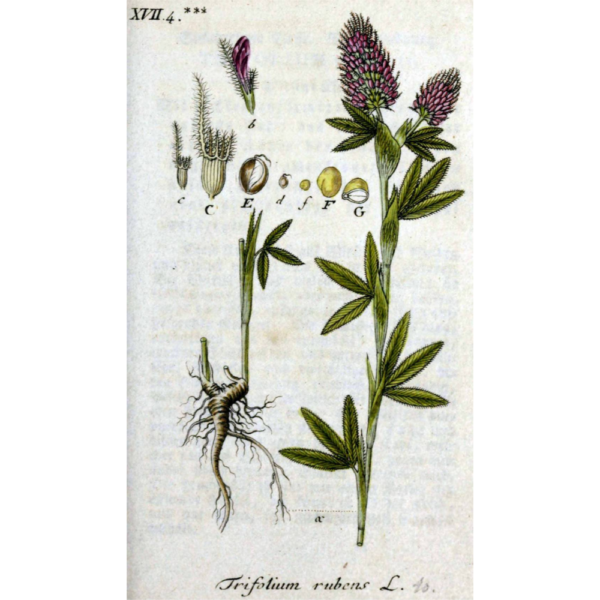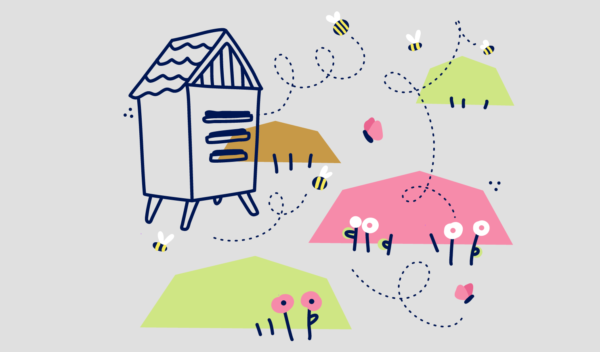It is a valuable and rare native perennial. Ruddy clover is an endangered species (VU category) that is characterized by high melliferousness. This plant prefers light, warm, fertile, and lime soils. Wild, non-cultivar seeds.
11,00 zł – 47,00 zł
SZYBKA WYSYŁKA
Zamówienia wysyłamy w 24h by każdy zakup dotarł do 3 dni roboczych.
BEZPIECZNE PŁATNOŚCI
Gwarantujemy bezpieczny, wygodny i szybki sposób dokonywania płatności.
POMOC I WSPARCIE
Oferujemy bezpłatne doradztwo i kompleksową opiekę pozakupową.
GWARANCJA JAKOŚCI
Dostarczamy profesjonalne i przemyślane mieszanki nasion.
Polish name: long-spiked clover
Latin Name: Trifolium rubens L.
Family: legumes Fabaceae
Status in Poland: native, rare and declining (category “vulnerable” on the Red List), but not legally protected
The ruddy clover is a durable plant with unusually elongated, as for a clover, inflorescences. It has an extensive, deeply overgrowing root system, made of a central taproot, and lots of secondary roots, all with root nodules.
It creates two types of underground shoots, the short rhizomes and the bare stems (which makes it quite different from the more common red clover with strongly mossy stems). The shoots rise to a height of 0.2-0.6 m. Its leaves are characterized by a oblong, lanceolate shape.
The single flowers of the ruddy clover retain the five-fold symmetry typical of the genus, and the pectinate papilionaceous shape. Each such flower consists of a calyx and a corolla. The calyx is characterized by a woolly texture and 12-20 strong veins. Measuring 12-15 mm in length, the corolla is characterized by the papilionaceous shape typical of the genus, and the family. Usually it has pastel shades of dark pink, or light beet purple. The inflorescences in the shape of highly elongated heads (30-70 mm long, and 20-30 mm wide in Poland, further east slightly larger, up to 100 mm long, and 40 mm wide), slightly similar to fluffy fox tails, usually grow in pairs at the tops of the stems.
The fruit of this clover is, like its cousins, a single-grained, broadly ovoid or almost perfectly round pod. The seed hidden in it is small, hard and deeply dormant.


This plant prefers bright, warm, fertile, clay, loess, brown, or black earth soils, and simultaneously rich in calcium or gypsum. In Poland in many sites, it would be worth liming the soil before growing a flower meadow rich in this species. As befits the species of steppes with high-growing groundcover, warm thickets and bright forests perfectly tolerates partial shade. Late mowing of bee pastures with ruddy clover favors both the production of honey, and more abundant seed production.
To protect the locations of the ruddy clover, a number of nature reserves were established, such as “Łysa Góra” near Lviv or “Winnica” in the Łódź voivodeship.
In Poland, where acidic soils are predominant, the ruddy clover is naturally rarer than in the steppes of Ukraine or in the limestone ranges of the Carpathians, and the Alps. In the west, and in the center of Europe, it is damaged by the overgrowing of xerothermic grasslands with shrubs, their afforestation, as well as the natural succession from bright oak forests down to shady hornbeam forests. In the territories of Russia and Ukraine, Trifolium rubens is dying as a result of plowing, or afforestation of the steppes, terracing the slopes, overgrazing, and finally, too frequent mowing of the steppes.
Ruddyclover is an important melliferous species. Although its individual flowers are usually 8-10 mm long, and the honeybee’s tongue 6 mm long, the bees can get to the nectar by biting into the side, or bottom of the flower. In its flowers it rises to a height of 4.5 mm, so even hymenopterans with tongues shorter than bumblebees can get it. Ukrainian and Russian beekeepers appreciate it more and more for its abundant nectarising. However, it stops during long lasting hot weather. In addition, the ruddy clover blooms shorter than white or red clover, only 2 months.

